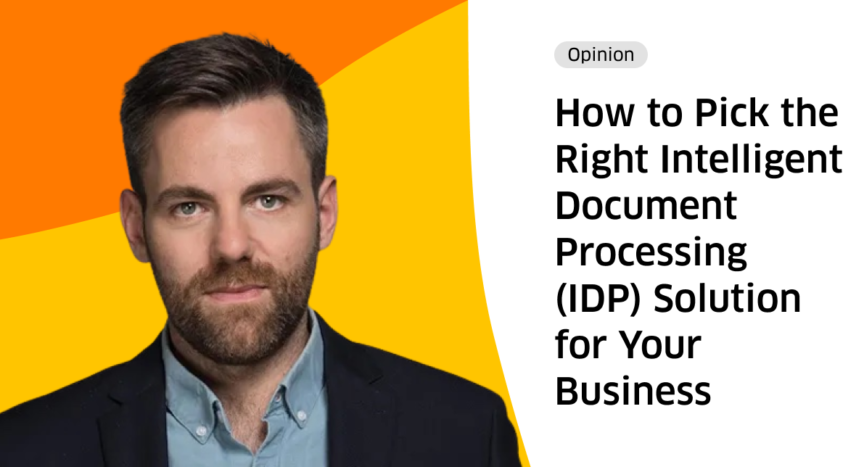Curious about what keeps experts, CEOs and other decision-makers in the Intelligent Document Processing (IDP) space on their toes? Get food for thought on IDP-related topics from the industry’s leading minds.
In this opinion piece, Jonathan Grandperrin, Co-Founder and CEO at Mindee, an API-first platform that helps developers automate applications’ workflows by standardizing the document processing layer using computer vision and machine learning, explains the key factors an organization should know when considering an IDP solution.
The intelligent document processing (IDP) market size was valued at nearly $2 billion in 2023 and is expanding very rapidly to grow at a rate of 28.9% from 2024 to 2033.
This high demand has resulted in a proliferation of options, making selecting an intelligent document processing (IDP) solution challenging for companies. In this article, I will go over the key factors that should be considered when choosing an IDP solution.
Understand your needs
Before examining what criteria companies should consider, it’s crucial to understand your specific needs to find the best IDP for them. This understanding begins with an assessment of your current or future document processing workflows. Evaluate and map out each step of these processes to pinpoint bottlenecks, repetitive tasks, or complete lack of document processing.
To illustrate this point, let’s go over the steps of a classical use case with invoice processing at a company:
- Collection of Invoices: Invoices are received via email.
- Sorting: An operator manually downloads and sorts the invoices.
- Data Entry: Data from the invoice, such as vendor name, invoice number, and amount, is manually entered into the accounting system.
- Approval: The invoice is sent for payment approval.
In this example, we can see two main issues. First, step two is prone to error; the operator can misread and mistype the entries. Second, steps two, three, and four are inefficient and consume valuable staff time. Therefore, in your IDP search, you should focus on addressing those specific pain points.
Following this assessment, the next critical step is defining clear objectives for implementing an IDP solution. Consider what your company aims to achieve with this technology – whether it’s reducing manual data entry, improving the accuracy of data extracted from documents, or enhancing the user experience for users who interact with these systems. Make sure to define what success looks like, define metrics that would asses that, and plan on monitoring tools you will use to measure that.
Tech capabilities
When assessing IDP solutions, it’s essential to consider integration capabilities, customization, flexibility, and scalability.
The right IDP should seamlessly integrate with your existing IT infrastructure, supporting common programming languages like PHP, Node.js, Python, Ruby, and Java, and offer straightforward API access. This ensures that the IDP can easily connect with your systems without extensive modifications.
Customization and flexibility are equally critical. Opt for an IDP tool that allows customization to meet specific document processing requirements and can handle a broad range of document types – from routine invoices and identity documents to more complex formats found in FinTech, HRIS, and legal systems. Powered by LLMs, a new breed of training-less IDP offers previously unseen levels of flexibility. The end goal is to avoid needing multiple IDP solutions or going through a replacement.
Last, but not least, look at the solution’s ability to scale. The chosen IDP must be able to scale in response to your business growth and manage increasing document volumes efficiently. This capability ensures that the IDP remains performant and cost-efficient as your company’s needs expand; this is especially important for applications that need real-time response times.
Accuracy
Accuracy is a critical criterion when selecting an IDP solution. It’s a well-known factor, so I’ll keep the discussion brief. Choosing solutions with at least a 90% accuracy rate is advisable. However, the required level of accuracy may vary depending on how the system is used.
For instance, in scenarios where the IDP is used to pre-fill fields that will later be verified by users, perfect accuracy may not be as crucial. Contrarily, in fully automated processes where the extracted values are not subject to human verification, a higher accuracy rate is essential to ensure reliability and effectiveness.
And because the only way to find out about the accuracy of an IDP is to try it, test the solution using a sample set of your own documents by using a free trial, or ask for an account manager for a test account. If that’s not possible, it’s a red flag that you should not ignore.
Precision
Precision and accuracy are often mixed up. Stakeholders need to ensure they understand the difference and may want to consider this as a criterion depending on the use case. Precision focuses on the subset of data that the IDP system identifies as relevant and measures how much of this identified data is correct. Precision is vital when the cost of extracting incorrect data is high. For example, in a legal document, extracting and using incorrect data could lead to significant legal implications. Precision is crucial when you want to minimize false positives — cases where the system extracts data that it should have ignored.
Security and Compliance
When choosing an IDP solution, security and regulatory compliance are paramount, and it is an often overlooked topic. With over 70% of countries having some sort of data protection and privacy legislation, the topic isn’t going away.
Users should look for solutions that are in compliance with relevant regulations, for example GDPR for EU usage, HIPAA for handling healthcare information in the US, and SOC 2 Type II for the US.
From a pure security standpoint, it is also essential to verify that the provider has robust security protocols, such as data encryption on API endpoints and secure data storage, and can, in general, clearly explain how users’ data is managed within its infrastructure.
Cost-effectiveness
Evaluating the total cost of ownership (TCO) includes not only the initial setup and maintenance costs but also the ease of expanding its use, such as configuring new API endpoints, processing new document types, data migration fees, customization needs, and ongoing vendor support.
If the solution is not out-of-the-box, the complexity of the setup and ongoing maintenance, particularly the training requirements, should be assessed. This is especially relevant for organizations considering open-source solutions, where engineering and data scientist salaries can significantly inflate the TCO.
Pricing models in the IDP industry vary, ranging from per-document or per-page charges to subscription-based models. Depending on the business’s intended usage, these should be carefully compared to determine the most economical choice. As you can see, the TCO can be multifaceted, and it can be hard to determine which solution is offering the best ROI. Using a price comparison framework will ensure a like-for-like evaluation.
Robustness of the company
The obvious way to assess vendors’ reputations is to review case studies and customer testimonials. Try to look for customers in the same industry or who may have similar requirements. Engaging directly with existing customers can provide deeper insight into the provider’s performance and reliability.
Depending on how critical the tasks performed by your IDP are, the support and service levels offered by the provider should be considered. For instance, assess the type of SLA the IDP is providing, a three-nines availability (99.9%) means that the vendor service may be unavailable for up to 8 hours and 46 minutes per year.
Robust providers also offer comprehensive support options, including high availability, live support, and self-service resources. If you go with an open-source solution, look for how active the project is, such as the number of commits, open issues, contributors, and which companies or organizations are backing the project.
Growth potential
Last but not least, users should look for companies with a strong technical team that goes beyond utilizing publicly accessible APIs and instead invest in developing their own deep learning AI frameworks and computer vision capabilities. This results in solutions that are not only more adaptable to diverse document types and formats but also exhibit greater accuracy and operational efficiency. Such companies are better positioned to innovate and respond to your business’s evolving needs in the long run.

About the Author
Jonathan Grandperrin is the Co-Founder and CEO at Mindee, an API-first platform that helps developers automate applications’ workflows by standardizing the document processing layer using computer vision and machine learning.
📨Get IDP industry news, distilled into 5 minutes or less, once a week. Delivered straight to your inbox ↓







